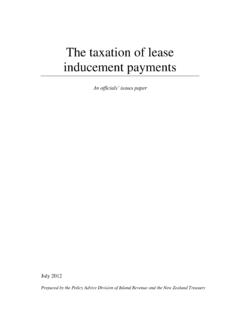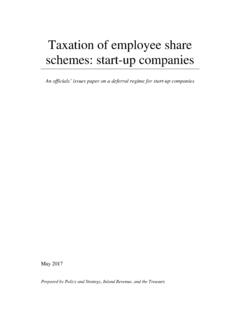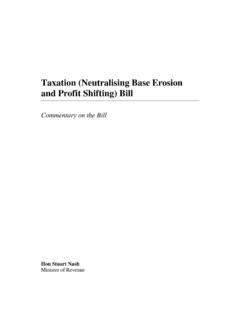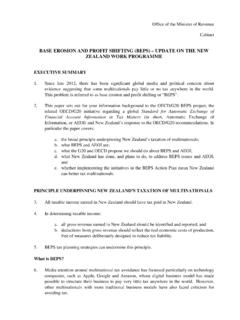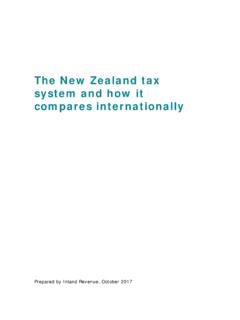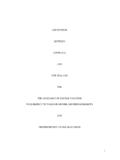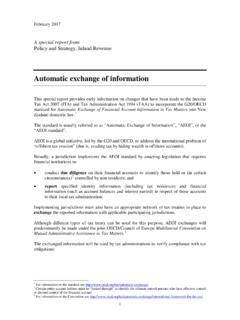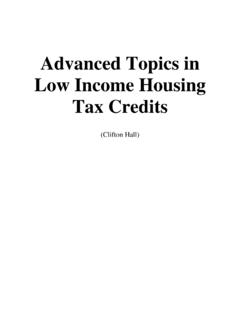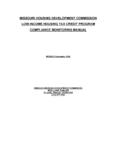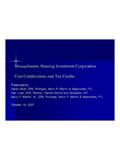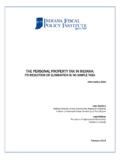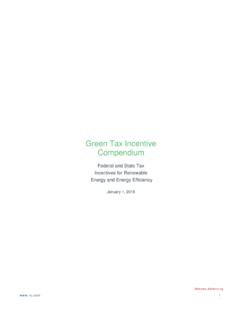Transcription of Ring-fencing rental losses - taxpolicy.ird.govt.nz
1 Ring-fencing rental losses An officials issues paper March 2018 Prepared by Policy and Strategy, Inland Revenue, and the Treasury First published in March 2018 by Policy and Strategy, Inland Revenue, PO Box 2198, Wellington, 6140. Ring-fencing rental losses an officials issues paper. ISBN 0-978-0-478-42445-4 CONTENTS CHAPTER 1 Introduction 1 Background 1 Current settings 1 Aim of the proposed changes 2 How to make a submission 2 CHAPTER 2 Summary of the suggested changes 3 property the rules will apply to 3 Portfolio basis 3 Using ring-fenced losses 4 Interposed entities 4 Timing of the introduction of the rules 4 CHAPTER 3 property the rules will apply to 5 Definition of residential land 5 Main home 6 Mixed-use assets 6 Revenue account land in dealing, development, subdivision and building businesses 7 property owned by companies and trusts 7 CHAPTER 4 Portfolio basis 9 CHAPTER 5 Using ring-fenced losses 10 CHAPTER 6 Structuring around the rules 12 Interest allocation 12 Interposed entities 12 CHAPTER 7 Timing of introduction of the rules 16 CHAPTER 1 Introduction Background The Government has committed to a number of policy measures aimed at making the tax system fairer and improving housing affordability for owner-occupiers by reducing demand from speculators and investors.
2 One of these measures is to introduce loss Ring-fencing on residential properties held by speculators and investors. This means that speculators and investors will no longer be able to offset tax losses from their residential properties against their other income (for example, salary or wages, or business income), to reduce their income tax liability. Current settings Under current New Zealand tax settings, tax is applied on a person s net income. We do not generally ring-fence income and losses from particular activities or investments. This means that there is generally no restriction on losses from one source reducing income from other sources though there are some exceptions to this general Investment housing is currently taxed under the same rules that generally apply to other investments.
3 This means that rents are income, and interest and other expenses (other than capital improvements) are deductible. Capit al gains on sale of the property are not taxed unless the property is on revenue account. This could be, for example, because you are in a land-related business (for example, a land dealer or developer), bought the land for resale, or sell the property within the bright-line period of either two or five years (depending on when you first had an interest in the land).2 Most rental property investors hold their property on capital account and are not subject to tax on the capital gain. While rental housing is not formally tax favoured, there is an argument that it may be under-taxed given that tax-free capital gains are often realised when rental properties are sold. The fact that rental property investors often make persistent tax losses indicates that expected capital gains are an important motivation for many investors purchasing rental property .
4 While interest and other expenses are fully deductible, in the absence of a comprehensive 1 For example, there are loss Ring-fencing rules in relation to the bright-line test, which taxes sales of residential land bought and sold within either two or five years (depending on when you first had an interest in the land), and also in relation to the mixed-use asset rules, which may apply to assets that are used both privately and to earn income. 2 The bright-line period is two years if you first acquired an estate or interest in the land on or after 1 October 2015, but is five years if you first acquired an estate or interest in the land on or after the date the Taxation (Annual Rates for 2017 18, Employment and Investment Income, and Remedial Matters) Act 2017 is enacted. 1 capital gains tax, not all of the economic income generated from rental housing is subject to tax.
5 There is therefore an argument that, to the extent deductible expenses in the long-term exceed income from rents, those expenses in fact relate to the capital gain, so should not be deductible unless the capital gain is taxed. Aim of the proposed changes The introduction of loss Ring-fencing rules is aimed at levelling the playing field between property speculators/investors and home buyers. Currently investors (particularly highly-geared investors) have part of the cost of servicing their mortgages subsidised by the reduced tax on their other income sources, helping them to outbid owner-occupiers for properties. Rules that ring-fence residential property losses , so they cannot be used to reduce tax on other income, is intended to help reduce this advantage and perceived unfairness. Officials are interested in feedback on the suggested changes outlined in this paper.
6 How to make a submission Officials invite submissions on the suggested changes and points raised in this issues paper. Send your submission to with Ring-fencing rental losses in the subject line. Alternatively, submissions can be sent to: Ring-fencing rental losses C/- Deputy Commissioner, Policy and Strategy Inland Revenue Department PO Box 2198 Wellington 6140 The closing date for submissions is 11 May 2018. Submissions should include a brief summary of major points and recommendations. They should also indicate whether it would be acceptable for Inland Revenue and Treasury officials to contact those making the submission to discuss the points raised, if required. Submissions may be the subject of a request under the Official Information Act 1982, which may result in their release. The withholding of particular submissions, or parts thereof, on the grounds of privacy, or commercial sensitivity, or for any other reason, will be determined in accordance with that Act.
7 Those making a submission who consider that there is any part of it that should properly be withheld under the Act should clearly indicate this. 2 CHAPTER 2 Summary of the suggested changes The proposed loss Ring-fencing rules will mean that speculators and investors with residential properties will no longer be able to offset tax losses from those properties against their other income (for example, salary or wages, or business income), to reduce their tax liability. The losses can be used in future years, when the properties are making profits, or if the person is taxed on the sale of land. A summary of officials suggestions for the design of the loss Ring-fencing rules is set out below. These design issues are discussed in more detail in the chapters that follow. property the rules will apply to It is proposed that the loss Ring-fencing rules will apply to residential land.
8 We suggest that the rules use the definition of residential land 3 that already exists for the bright-line test which taxes sales of residential land bought and sold within eit her two or five The rules would not apply to: a person s main home; a property that is subject to the mixed-use assets rules (for example, a bach that is sometimes used privately and sometimes rented out); or land that is on revenue account because it is held in a land-related business5 (that is, a business of land dealing, development of land, division of land, or building). Portfolio basis It is suggested that the loss Ring-fencing rules should apply on a portfolio basis. That would mean that investors would be able to offset losses from one rental property against rental income from other properties calculating their overall pro fit or loss across their portfolio.
9 3 In section YA 1 of the Income Tax Act 2007. 4 The bright-line period is two years if you first acquired an estate or interest in the land on or after 1 October 2015, but is five years if you first acquired an estate or interest in the land on or after the date the Taxation (Annual Rates for 2017 18, Employment and Investment Income, and Remedial Matters) Act 2017 is enacted. 5 As per section CB 7 of the Income Tax Act 2007. 3 Using ring-fenced losses Under the suggested changes, a person s ring-fenced resident ial rental or other losses from one year could be offset against their: residential rental income from future years (from any property ); and taxable inco me on the sale of any residential land. Interposed entities Under the suggested changes, there would be special rules to ensure that trust, company, partnership, or look-through company cannot be used to get around the Ring-fencing rules.
10 It is proposed that such an entity will be regarded as residential property land-rich if over 50 percent of its assets are residential properties within the scope of the Ring-fencing rules, and/or shares or interests in other residential property land-rich entities. Where that is the case, it is suggested that any interest a person incurs on money they borrow to acquire an interest in the entity (for example, shares, securities, a partnership interest, or an interest in the trust estate) would be treated as rental property loan interest. The rules could then ensure that the interest deduction is only allocated to the income year in question to the extent it did not exceed the distributions from the entity (deemed rental property income), any other residential rental income, and residential land sale income.
